Long-nosed Snake - Rhinocheilus lecontei
Baird and Girard, 1853Description • Taxonomy • Species Description • Scientific Name • Alt. Names • Similar Herps • References • Conservation Status
 |
 |
||||||||||||||||||||||||||||||||||||||||||||||||||
| Adult, San Diego County | Adult, San Diego County | ||||||||||||||||||||||||||||||||||||||||||||||||||
 |
 |
 |
 |
||||||||||||||||||||||||||||||||||||||||||||||||
| Adult, San Diego County | Adult, Inyo County © Ryan Sikola | ||||||||||||||||||||||||||||||||||||||||||||||||||
 |
 |
 |
 |
||||||||||||||||||||||||||||||||||||||||||||||||
| Adult, Alameda County | Adult, Imperial County | Adult, coastal Riverside County © Nick Barrientos |
|||||||||||||||||||||||||||||||||||||||||||||||||
 |
 |
 |
 |
||||||||||||||||||||||||||||||||||||||||||||||||
| Adult, Alameda County | Adult, San Benito County © Neo S | Adult, Bakersfield, Kern County © Patrick Briggs |
|||||||||||||||||||||||||||||||||||||||||||||||||
 |
 |
 |
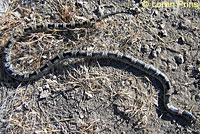 |
||||||||||||||||||||||||||||||||||||||||||||||||
| Adult, coastal San Diego County © Bill Bachman |
Adult, coastal San Diego County © Aaron Wells |
Adult, Lassen County © Loren Prins | |||||||||||||||||||||||||||||||||||||||||||||||||
 |
 |
 |
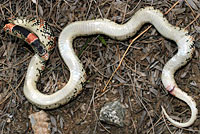 |
||||||||||||||||||||||||||||||||||||||||||||||||
| Adult, Kern County © Ryan Sikola | Adult, Riverside County desert © Cooper Bailey |
Adult, coastal Riverside County © Nick Barrientos |
Underside of adult, San Diego County | ||||||||||||||||||||||||||||||||||||||||||||||||
 |
 |
 |
 |
||||||||||||||||||||||||||||||||||||||||||||||||
| Adult, Stanislaus County © Jared Heald | Adult found a couple of miles north of Bakersfield in Kern County | Adult found in San Benancio Canyon west of Salinas in Monterey County. | Adult, coastal San Diego County © Taylor Henry |
||||||||||||||||||||||||||||||||||||||||||||||||
 |
 |
 |
 |
||||||||||||||||||||||||||||||||||||||||||||||||
| Adult from the Central Valley near Bakersfield, Kern County © Zeev Nitzan Ginsburg | Adult and habitat in the San Bernardino County desert © Zeev Nitzan Ginsburg | ||||||||||||||||||||||||||||||||||||||||||||||||||
 |
 |
 |
 |
||||||||||||||||||||||||||||||||||||||||||||||||
| Adult, Tuolumne County © Emile Bado | Adult, Diablo Range, San Benito County © Faris K |
||||||||||||||||||||||||||||||||||||||||||||||||||
 |
 |
||||||||||||||||||||||||||||||||||||||||||||||||||
| Adult, Mono County © Adam Clause | Adult, Mono County © Adam Clause | ||||||||||||||||||||||||||||||||||||||||||||||||||
| Juveniles | |||||||||||||||||||||||||||||||||||||||||||||||||||
 |
 |
 |
|||||||||||||||||||||||||||||||||||||||||||||||||
| Juvenile, San Bernardino County © Ryan Sikola |
Juvenile, Tuolumne County © Emile Bado |
Juvenile, Stanislaus County © Adam Gitmed |
|||||||||||||||||||||||||||||||||||||||||||||||||
 |
 |
||||||||||||||||||||||||||||||||||||||||||||||||||
| Neonate, Santa Barbara County © Daniel Koury | |||||||||||||||||||||||||||||||||||||||||||||||||||
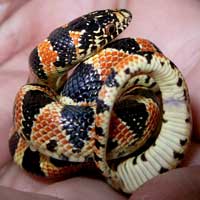 |
 |
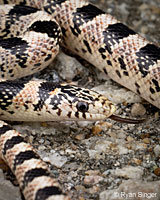 |
|||||||||||||||||||||||||||||||||||||||||||||||||
| Juvenile, Contra Costa County. © Richard Porter |
Juvenile, found in San Luis Obispo County in a new location west of the Carrizo Plain © Ryan Singer |
||||||||||||||||||||||||||||||||||||||||||||||||||
| Long-nosed Snakes With Little or No Red Coloring (Clarus Phase) | |||||||||||||||||||||||||||||||||||||||||||||||||||
 |
|||||||||||||||||||||||||||||||||||||||||||||||||||
| Adult with little red, San Diego County | |||||||||||||||||||||||||||||||||||||||||||||||||||
 |
 |
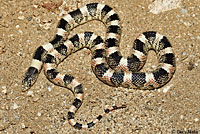 |
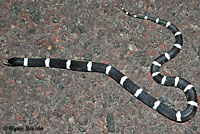 |
||||||||||||||||||||||||||||||||||||||||||||||||
| Adult with little red, San Diego County | "Clarus" phase adult lacking red, San Diego County © Dick Bartlett | Adult with faint red, San Diego County | This adult found in Inyo County lacks the red that is usually found on this species, and has a much lower band count than is normal with few of the white markings that are typically found on the dark bands. © Ryan Sikola | ||||||||||||||||||||||||||||||||||||||||||||||||
 |
 |
||||||||||||||||||||||||||||||||||||||||||||||||||
| Anerythristic adult, Inyo County © Chris Morrison |
Adult, Mono County © Adam Clause | ||||||||||||||||||||||||||||||||||||||||||||||||||
| Long-nosed Snakes With Unusual Coloring or Patterns | |||||||||||||||||||||||||||||||||||||||||||||||||||
 |
 |
||||||||||||||||||||||||||||||||||||||||||||||||||
| Adult male, Kern County, with more red pigment and less black pigment than is typically found on the species, and a pink tongue. © Daniel Koury | |||||||||||||||||||||||||||||||||||||||||||||||||||
| Long-nosed Snake Defensive Behavior | |||||||||||||||||||||||||||||||||||||||||||||||||||
 |
 |
 |
 |
||||||||||||||||||||||||||||||||||||||||||||||||
| San Diego County adult exhibiting "cloacal auto-hemorrhage" behavior where it smears cloacal blood all over itself to deter attacks. | Adult, San Diego County, in defensive position after having smeared itself with blood. © William Flaxington | This short video shows a Long-nosed Snake using a disgusting but effective defensive behavior - it coils up with jerky movements then smears itself with red fluid from its cloaca. After that I certainly did not want to touch the snake again. | Lassen County adult auto-hemmhoraging. © Don Cain | ||||||||||||||||||||||||||||||||||||||||||||||||
| Long-nosed Snakes Feeding | |||||||||||||||||||||||||||||||||||||||||||||||||||
 |
 |
 |
 |
||||||||||||||||||||||||||||||||||||||||||||||||
| Chad M. Lane found this adult Long-nosed Snake in Alameda County eating another adult Long-nosed Snake. A report of the sighting was published in Herp Review in 2009 as the first documented occurrence of cannibalistic behavior in this species. © Chad M. Lane | Battle of the Long-Noses An adult Long-nosed Snake was found in Kern County coiled around a Long-nosed Leopard Lizard, attempting to swallow the lizard. The lizard managed to keep its mouth outside the snake's mouth and after 20 minutes, the lizard was able to escape the snake's coils and quickly limp away. It's not known if the lizard survived or died later from its injuries. © Greg Watson |
||||||||||||||||||||||||||||||||||||||||||||||||||
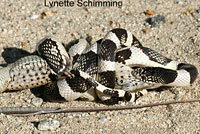 |
 |
 |
|||||||||||||||||||||||||||||||||||||||||||||||||
| Adult eating a Great Basin Whiptail, Riverside County © Lynette Schimming | |||||||||||||||||||||||||||||||||||||||||||||||||||
| Habitat | |||||||||||||||||||||||||||||||||||||||||||||||||||
 |
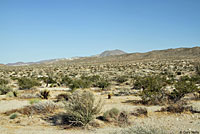 |
 |
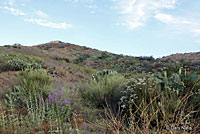 |
||||||||||||||||||||||||||||||||||||||||||||||||
| Habitat, San Diego County desert | Habitat, San Diego County desert | Habitat, San Diego County desert | San Diego County coastal sage habitat | ||||||||||||||||||||||||||||||||||||||||||||||||
 |
 |
 |
 |
||||||||||||||||||||||||||||||||||||||||||||||||
| Habitat, Alameda County grassland | Habitat, Alameda County grassland | Habitat, Alameda County grassland | Habitat, Riverside County desert riparian | ||||||||||||||||||||||||||||||||||||||||||||||||
 |
 |
||||||||||||||||||||||||||||||||||||||||||||||||||
| Habitat, east side of Santa Ana Mountains, Riverside County © Nick Barrientos |
Habitat, San Bernardino County desert | ||||||||||||||||||||||||||||||||||||||||||||||||||
| Short Videos | |||||||||||||||||||||||||||||||||||||||||||||||||||
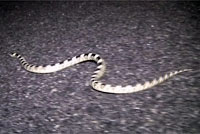 |
 |
 |
 |
||||||||||||||||||||||||||||||||||||||||||||||||
| A Long-nosed snake crawls across a road in San Diego County. | This video shows a Long-nosed Snake using a disgusting but effective defensive behavior - it coils up with jerky movements then smears itself with red fluid from its cloaca. After that I certainly did not want to touch the snake again. | A black and white Long-nosed snake crawls at night in the Arizona desert. | Watching this short video you can get an idea of how this fairly fast snake moves. |
||||||||||||||||||||||||||||||||||||||||||||||||
|
|||||||||||||||||||||||||||||||||||||||||||||||||||
|
|||||||||||||||||||||||||||||||||||||||||||||||||||
|
The following conservation status listings for this animal are taken from the July 2025 State of California Special Animals List and the July 2025 Federally Listed Endangered and Threatened Animals of California list (unless indicated otherwise below.) Both lists are produced by multiple agencies every year, and sometimes more than once per year, so the conservation status listing information found below might not be from the most recent lists, but they don't change a great deal from year to year.. To make sure you are seeing the most recent listings, go to this California Department of Fish and Wildlife web page where you can search for and download both lists: https://www.wildlife.ca.gov/Data/CNDDB/Plants-and-Animals. A detailed explanation of the meaning of the status listing symbols can be found at the beginning of the two lists. For quick reference, I have included them on my Special Status Information page. If no status is listed here, the animal is not included on either list. This most likely indicates that there are no serious conservation concerns for the animal. To find out more about an animal's status you can also go to the NatureServe and IUCN websites to check their rankings. Check the current California Department of Fish and Wildlife sport fishing regulations to find out if this animal can be legally pursued and handled or collected with possession of a current fishing license. You can also look at the summary of the sport fishing regulations as they apply only to reptiles and amphibians that has been made for this website. This animal is not included on the Special Animals List, which indicates that there are no significant conservation concerns for it in California. |
||
| Organization | Status Listing | Notes |
| NatureServe Global Ranking | ||
| NatureServe State Ranking | ||
| U.S. Endangered Species Act (ESA) | None | |
| California Endangered Species Act (CESA) | None | |
| California Department of Fish and Wildlife | None | |
| Bureau of Land Management | None | |
| USDA Forest Service | None | |
| IUCN | ||
|
|
||
Return to the Top
© 2000 -



